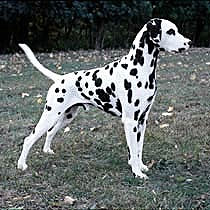|
The Canine Chronicles Directory
Dalmatian

Dalmatians are well-balanced, sturdy, and muscular dogs. They are symmetrical, with
a medium build and a superior endurance. Dalmatians are unusual due to their unique
spotted coats. The short white coat is sleek and shiny with defined, well distributed
black or liver spots. Puppies are born entirely white, their spots developing as
they mature. The head is medium in length with a moderately defined stop. In the
black spotted dogs, the medium sized eyes are dark and the nose is black. In the
liver spotted dogs, the eyes are amber and the nose brown. The ears should sit high
on the head and should be of moderate size. Markings should be well distributed,
spotted markings preferred. The jaw should be strong with the teeth meeting in a
scissor-like bite. The slightly arched neck should be long merging into the shoulders.
The level back should have clear withers and well sprung ribs. The strong round-boned
forelegs should be straight with the elbows close to the body. The second thigh
should be strong with well defined hocks. The feet should be round and catlike.
The tail is medium in length reaching to the hock and curves slightly upwards.
|
|
Temperament
|
Dalmatians are outgoing, playful, fun-loving and friendly dogs. They are mild mannered,
affectionate and extremely loyal. They need human companionship and are great around
children. They also get along with other pets although males can be aggressive towards
other males. This can be managed through socialization. Dalmatians have an incredible
stamina and usually take about two years before they settle down. Dalmatian puppies
can become hyper and form bad habits if not properly trained.
|
|
Height, Weight
|
Male Height: 22-24" ; Weight: About 55 lbs.
Female Height: 20-22" ; Weight: About 55 lbs.
|
|
Health Problems
|
Because of the white factor, a percentage of Dalmatian puppies are born permanently
deaf. Every Dal puppy should be tested for deafness at about 6 weeks. Prospective
owners should be cautioned about raising a deaf dog. They are difficult to raise
as they may become aggressive from fear. This breed is also very prone to Urinary
stones which can cause a blockage in the urinary tract. They are also prone to skin
allergies.
|
|
Living Conditions
|
Dalmatians should not live in an apartment. They are a very active breed and need
lots of room to run. They need to be walked several times a day. They should not
be kept outside during cold weather.
|
|
Exercise
|
This breed has lots of energy and is very active. They need to be able to run and
romp daily.
|
|
Life Expectancy
|
About 10-12 years
|
|
Grooming
|
The Dal is an easy breed to groom though they need frequent brushing because of
the constant shedding. They have no dog odor and are very clean. Bathe only when
necessary.
|
|
Origin
|
The origin of Dalmatians is uncertain. However, it is known that they are an ancient
breed. Records have indicated their history dates back to 2000 B.C. Greek friezes
and tablets have shown them working with chariots in ancient Greece, Rome and Egypt.
Early records of the breed are found in Dalmatia, Croatia which is where Dalmatians
received their name. Whatever their origin, Dalmatians have been working with horses
since the Middle Ages, if not prior to that. Dalmatians have also been used as dogs
of war, border patrols, cart pullers, sheep herders, dogs of the hunt, circus performers
and coaching dogs. The breed was introduced in Britain during the 18th century and
became very popular with the aristocracy. They were great accessories to their ornate
carriages and due to their ability to work horses under both the rear and front
of the carriage axles were in great demand. During the 19th century, Dalmatians
were adopted by fire departments. They were used to precede horse-drawn water wagons
clearing the way to the fire. This breed is recognized by the AKC and the UKC.
|
|
Group
|
AKC Non-Sporting, UKC Companion Dog
|